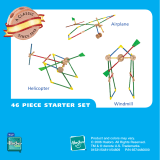
9
SAFETY PRECAUTIONS
Protect Your Model, Yourself & Others…Follow These Important Safety Precautions
1. Your L-39 should not be considered a toy, but rather a sophisticated, working model that functions very much like a full-size
airplane. Because of its performance capabilities, the L-39, if not assembled and operated correctly, could possibly cause injury
to yourself or spectators and damage to property.
2. You must assemble the model according to the instructions. Do not alter or modify the model, as doing so may result in an
unsafe or unflyable model. In a few cases the instructions may differ slightly from the photos. In those instances the written
instructions should be considered as correct.
3. You must take time to build straight, true and strong.
4. You must correctly install all R/C and other components so that the model operates correctly on the ground and in the air.
5. You must check the operation of the model before every flight to insure that all equipment is operating and that the model has
remained structurally sound. Be sure to check pushrod connectors or servo arms often and replace them if they show any
signs of wear or fatigue.
6. If you are not an experienced pilot or have not flown this type of model before, we recommend that you get the assistance of an
experienced pilot in your R/C club for your first flights. If you’re not a member of a club, your local hobby shop has information
about clubs in your area whose membership includes experienced pilots.
We, as the kit manufacturer, provide you with a top quality, thoroughly tested kit and instructions, but ultimately the quality and
flyability of your finished model depends on how you build it; therefore, we cannot in any way guarantee the performance of your
completed model, and no representations are expressed or implied as to the performance or safety of your completed model.
Remember: Take your time and follow the instructions to end up with a well-built model that is straight and true.
LITHIUM BATTERY PRECAUTIONS
WARNING!! Read the entire instruction sheet included with the battery. Failure to follow all instructions could cause permanent
damage to the battery and its surroundings, and cause bodily harm!
● ONLY use a LiPo approved charger. NEVER use a NiCd/
NiMH peak charger!
● NEVER charge in excess of 4.20V per cell.
● ONLY charge through the “charge” lead. NEVER charge
through the “discharge” lead.
● NEVER charge at currents greater than 1C.
● ALWAYS set charger’s output volts to match battery volts.
● ALWAYS charge in a fireproof location.
● NEVER trickle charge.
● NEVER allow battery temperature to exceed 150° F (65° C).
● NEVER disassemble or modify pack wiring in any way or
puncture cells.
● NEVER discharge below 2.5V per cell.
● NEVER place on combustible materials or leave unattended
during charge or discharge.
● ALWAYS KEEP OUT OF REACH OF CHILDREN.
ACADEMY OF MODEL AERONAUTICS
If you are not already a member of the AMA, please join! The AMA is the governing body of model aviation and membership
provides liability insurance coverage, protects modelers’ rights and interests and is required to fly at most R/C sites.
Tele. (800) 435-9262
Fax (765) 741-0057
modelaircraft.org
Academy of Model Aeronautics
5151 East Memorial Drive
Muncie, IN 47302-9252
REPLACEMENT PARTS
Replacement parts may be purchased from your local hobby dealer or on-line. For assistance with defective or missing parts
or purchasing replacement parts, contact Flyzone Product Support at the contact information on the front cover of this manual.
FLZA6535 Wing Set with Tips
FLZA6536 Fuselage with Hatch
FLZA6537 Tail Set
FLZA6538 Canopy Hatch
FLZA6539 Tip Tanks (2)
FLZA6540 Decal Sheet
FLZA6542 Display Stand
GPMG3910 HyperFlow Ducted Fan Unit
GPMG3940 Ducted Fan Rotor Blade
GPMG3941 Ducted Fan Misc. Parts
GPMG3942 Ducted Fan Outer Duct
GPMG3943 Ducted Fan Adapter
















